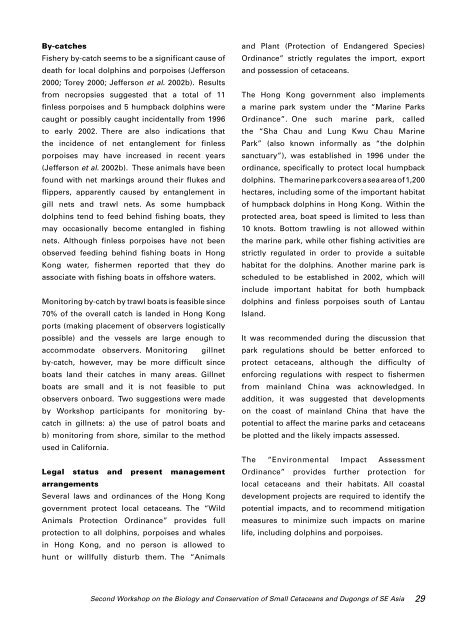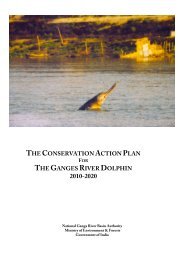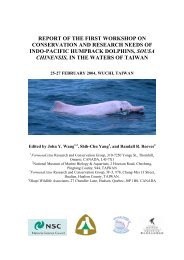Report of the Second Workshop on The Biology and Conservation of ...
Report of the Second Workshop on The Biology and Conservation of ...
Report of the Second Workshop on The Biology and Conservation of ...
Create successful ePaper yourself
Turn your PDF publications into a flip-book with our unique Google optimized e-Paper software.
By-catchesFishery by-catch seems to be a significant cause <str<strong>on</strong>g>of</str<strong>on</strong>g>death for local dolphins <strong>and</strong> porpoises (Jeffers<strong>on</strong>2000; Torey 2000; Jeffers<strong>on</strong> et al. 2002b). Resultsfrom necropsies suggested that a total <str<strong>on</strong>g>of</str<strong>on</strong>g> 11finless porpoises <strong>and</strong> 5 humpback dolphins werecaught or possibly caught incidentally from 1996to early 2002. <strong>The</strong>re are also indicati<strong>on</strong>s that<str<strong>on</strong>g>the</str<strong>on</strong>g> incidence <str<strong>on</strong>g>of</str<strong>on</strong>g> net entanglement for finlessporpoises may have increased in recent years(Jeffers<strong>on</strong> et al. 2002b). <strong>The</strong>se animals have beenfound with net markings around <str<strong>on</strong>g>the</str<strong>on</strong>g>ir flukes <strong>and</strong>flippers, apparently caused by entanglement ingill nets <strong>and</strong> trawl nets. As some humpbackdolphins tend to feed behind fishing boats, <str<strong>on</strong>g>the</str<strong>on</strong>g>ymay occasi<strong>on</strong>ally become entangled in fishingnets. Although finless porpoises have not beenobserved feeding behind fishing boats in H<strong>on</strong>gK<strong>on</strong>g water, fishermen reported that <str<strong>on</strong>g>the</str<strong>on</strong>g>y doassociate with fishing boats in <str<strong>on</strong>g>of</str<strong>on</strong>g>fshore waters.M<strong>on</strong>itoring by-catch by trawl boats is feasible since70% <str<strong>on</strong>g>of</str<strong>on</strong>g> <str<strong>on</strong>g>the</str<strong>on</strong>g> overall catch is l<strong>and</strong>ed in H<strong>on</strong>g K<strong>on</strong>gports (making placement <str<strong>on</strong>g>of</str<strong>on</strong>g> observers logisticallypossible) <strong>and</strong> <str<strong>on</strong>g>the</str<strong>on</strong>g> vessels are large enough toaccommodate observers. M<strong>on</strong>itoring gillnetby-catch, however, may be more difficult sinceboats l<strong>and</strong> <str<strong>on</strong>g>the</str<strong>on</strong>g>ir catches in many areas. Gillnetboats are small <strong>and</strong> it is not feasible to putobservers <strong>on</strong>board. Two suggesti<strong>on</strong>s were madeby <str<strong>on</strong>g>Workshop</str<strong>on</strong>g> participants for m<strong>on</strong>itoring bycatchin gillnets: a) <str<strong>on</strong>g>the</str<strong>on</strong>g> use <str<strong>on</strong>g>of</str<strong>on</strong>g> patrol boats <strong>and</strong>b) m<strong>on</strong>itoring from shore, similar to <str<strong>on</strong>g>the</str<strong>on</strong>g> methodused in California.Legal status <strong>and</strong> present managementarrangementsSeveral laws <strong>and</strong> ordinances <str<strong>on</strong>g>of</str<strong>on</strong>g> <str<strong>on</strong>g>the</str<strong>on</strong>g> H<strong>on</strong>g K<strong>on</strong>ggovernment protect local cetaceans. <strong>The</strong> “WildAnimals Protecti<strong>on</strong> Ordinance” provides fullprotecti<strong>on</strong> to all dolphins, porpoises <strong>and</strong> whalesin H<strong>on</strong>g K<strong>on</strong>g, <strong>and</strong> no pers<strong>on</strong> is allowed tohunt or willfully disturb <str<strong>on</strong>g>the</str<strong>on</strong>g>m. <strong>The</strong> “Animals<strong>and</strong> Plant (Protecti<strong>on</strong> <str<strong>on</strong>g>of</str<strong>on</strong>g> Endangered Species)Ordinance” strictly regulates <str<strong>on</strong>g>the</str<strong>on</strong>g> import, export<strong>and</strong> possessi<strong>on</strong> <str<strong>on</strong>g>of</str<strong>on</strong>g> cetaceans.<strong>The</strong> H<strong>on</strong>g K<strong>on</strong>g government also implementsa marine park system under <str<strong>on</strong>g>the</str<strong>on</strong>g> “Marine ParksOrdinance”. One such marine park, called<str<strong>on</strong>g>the</str<strong>on</strong>g> “Sha Chau <strong>and</strong> Lung Kwu Chau MarinePark” (also known informally as “<str<strong>on</strong>g>the</str<strong>on</strong>g> dolphinsanctuary”), was established in 1996 under <str<strong>on</strong>g>the</str<strong>on</strong>g>ordinance, specifically to protect local humpbackdolphins. <strong>The</strong> marine park covers a sea area <str<strong>on</strong>g>of</str<strong>on</strong>g> 1,200hectares, including some <str<strong>on</strong>g>of</str<strong>on</strong>g> <str<strong>on</strong>g>the</str<strong>on</strong>g> important habitat<str<strong>on</strong>g>of</str<strong>on</strong>g> humpback dolphins in H<strong>on</strong>g K<strong>on</strong>g. Within <str<strong>on</strong>g>the</str<strong>on</strong>g>protected area, boat speed is limited to less than10 knots. Bottom trawling is not allowed within<str<strong>on</strong>g>the</str<strong>on</strong>g> marine park, while o<str<strong>on</strong>g>the</str<strong>on</strong>g>r fishing activities arestrictly regulated in order to provide a suitablehabitat for <str<strong>on</strong>g>the</str<strong>on</strong>g> dolphins. Ano<str<strong>on</strong>g>the</str<strong>on</strong>g>r marine park isscheduled to be established in 2002, which willinclude important habitat for both humpbackdolphins <strong>and</strong> finless porpoises south <str<strong>on</strong>g>of</str<strong>on</strong>g> LantauIsl<strong>and</strong>.It was recommended during <str<strong>on</strong>g>the</str<strong>on</strong>g> discussi<strong>on</strong> thatpark regulati<strong>on</strong>s should be better enforced toprotect cetaceans, although <str<strong>on</strong>g>the</str<strong>on</strong>g> difficulty <str<strong>on</strong>g>of</str<strong>on</strong>g>enforcing regulati<strong>on</strong>s with respect to fishermenfrom mainl<strong>and</strong> China was acknowledged. Inadditi<strong>on</strong>, it was suggested that developments<strong>on</strong> <str<strong>on</strong>g>the</str<strong>on</strong>g> coast <str<strong>on</strong>g>of</str<strong>on</strong>g> mainl<strong>and</strong> China that have <str<strong>on</strong>g>the</str<strong>on</strong>g>potential to affect <str<strong>on</strong>g>the</str<strong>on</strong>g> marine parks <strong>and</strong> cetaceansbe plotted <strong>and</strong> <str<strong>on</strong>g>the</str<strong>on</strong>g> likely impacts assessed.<strong>The</strong> “Envir<strong>on</strong>mental Impact AssessmentOrdinance” provides fur<str<strong>on</strong>g>the</str<strong>on</strong>g>r protecti<strong>on</strong> forlocal cetaceans <strong>and</strong> <str<strong>on</strong>g>the</str<strong>on</strong>g>ir habitats. All coastaldevelopment projects are required to identify <str<strong>on</strong>g>the</str<strong>on</strong>g>potential impacts, <strong>and</strong> to recommend mitigati<strong>on</strong>measures to minimize such impacts <strong>on</strong> marinelife, including dolphins <strong>and</strong> porpoises.<str<strong>on</strong>g>Sec<strong>on</strong>d</str<strong>on</strong>g> <str<strong>on</strong>g>Workshop</str<strong>on</strong>g> <strong>on</strong> <str<strong>on</strong>g>the</str<strong>on</strong>g> <strong>Biology</strong> <strong>and</strong> C<strong>on</strong>servati<strong>on</strong> <str<strong>on</strong>g>of</str<strong>on</strong>g> Small Cetaceans <strong>and</strong> Dug<strong>on</strong>gs <str<strong>on</strong>g>of</str<strong>on</strong>g> SE Asia 29





